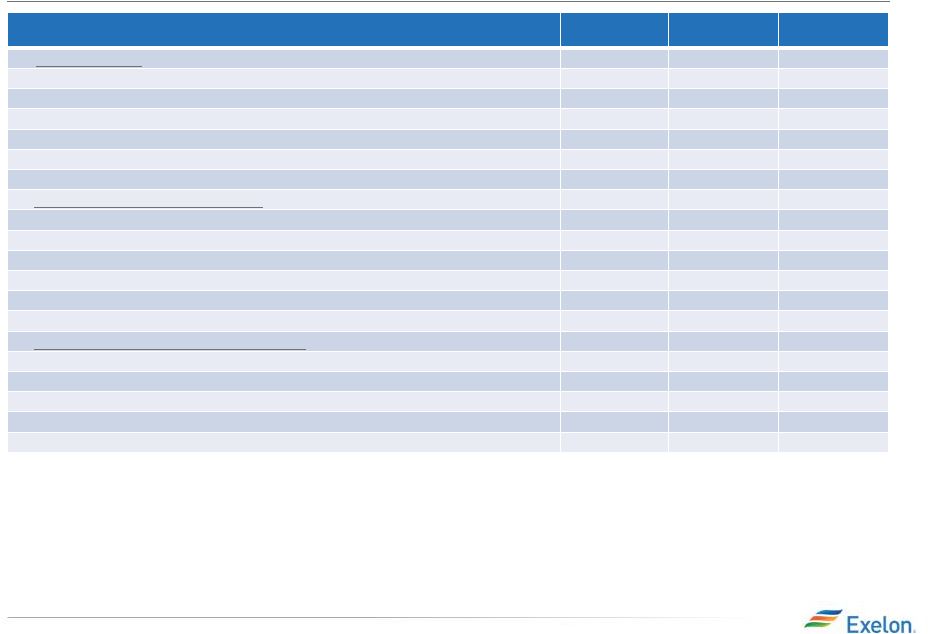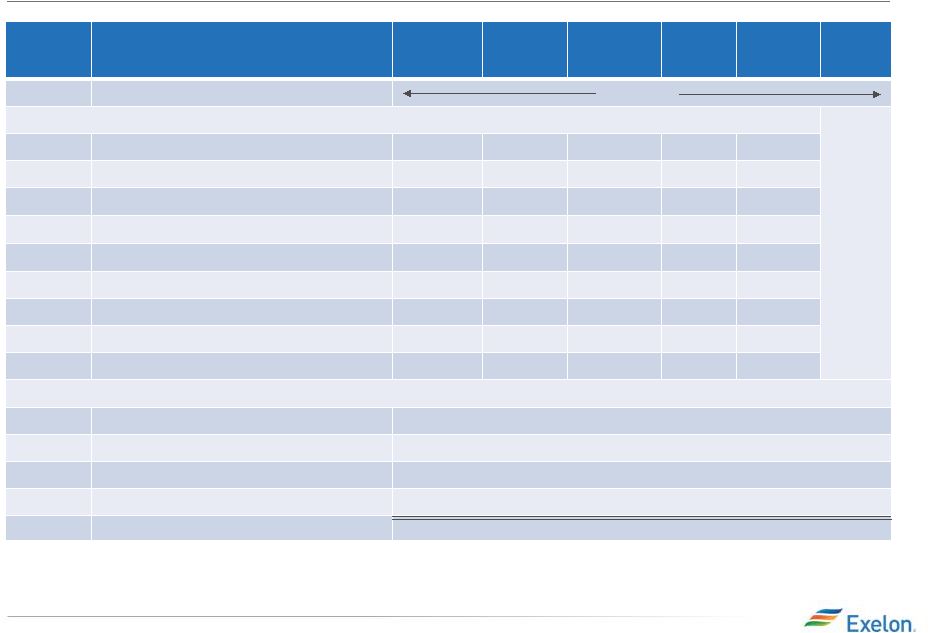Attached files
| file | filename |
|---|---|
| 8-K - FORM 8-K - EXELON GENERATION CO LLC | d410876d8k.htm |
 Bank of America Merrill Lynch
2012 Power and Gas Leaders
Conference
Bill Von Hoene
Senior EVP & Chief Strategy Officer
September
19th,
2012
Exhibit 99.1 |
 Cautionary Statements Regarding
Forward-Looking Information
This presentation contains certain forward-looking statements within the
meaning of the Private Securities Litigation Reform Act of 1995, that
are subject to risks and uncertainties. The factors that could cause actual
results to differ materially from the forward-looking statements made by
Exelon Corporation, Commonwealth Edison Company, PECO Energy Company,
Baltimore Gas and Electric Company and Exelon Generation Company, LLC
(Registrants) include those factors discussed herein, as well as the items discussed in (1) Exelon’s 2011
Annual Report on Form 10-K in (a) ITEM 1A. Risk Factors, (b) ITEM 7.
Management’s Discussion and Analysis of Financial Condition and
Results of Operations and (c) ITEM 8. Financial Statements and Supplementary Data:
Note 18; (2) Constellation Energy Group’s 2011 Annual Report on Form
10-K in (a) ITEM 1A. Risk Factors, (b) ITEM 7. Management’s
Discussion and Analysis of Financial Condition and Results of Operations and (c) ITEM 8.
Financial Statements and Supplementary Data: Note 12; (3) the Registrant’s
Second Quarter 2012 Quarterly Report on Form 10-Q in (a) Part II,
Other Information, ITEM 1A. Risk Factors; (b) Part 1, Financial Information,
ITEM 2. Management’s Discussion and Analysis of Financial Condition and
Results of Operations and (c) Part I, Financial Information, ITEM 1.
Financial Statements: Note 16; and (4) other factors discussed in filings with the
SEC
by
the
Registrants.
Readers
are
cautioned
not
to
place
undue
reliance
on
these
forward-looking
statements,
which apply only as of the date of this presentation. None of the Registrants
undertakes any obligation to publicly release any revision to its
forward-looking statements to reflect events or circumstances after the date
of this presentation.
1 |
 Maintaining Strength Under Current Market Conditions
2
Our business decisions will be reflective of various considerations including
current market views, our internal fundamental views and the method to
most effectively create and return value to shareholders
Current forward power prices do not reflect anticipated recovery
•
Our internal market analysis forecasts $3/MWh upside at PJW-WHUB and $5/MWh
upside at NIHUB
•
Power
markets
do
not
reflect
tightening
of
the
supply
stack
from
coal retirements and
MATS compliance costs
Options are available to manage through the downturn
•
Currently reviewing plans to identify additional cost savings
•
Re-evaluating the timing and amount of uprate and renewable spend
|
 3
Constellation: Electric Retail Business Strategy
Constellation
is
well
positioned
in
a
U.S.
market
where
capacity
available
for
competitive supply has room to grow
Total U.S. Power Market in 2012
Estimated Load ~ 3,700 TWh
(1)
(1) Source: EIA, KEMA and internal estimates.
Through retail and wholesale channels, Constellation
currently serves 170 TWhs, or approximately 5%, of total
U.S. power demand
Expected Total Competitive Market Growth
•
Underlying load growth
–
More than 1% annual load growth across the U.S.
•
Switched market expected to grow by approximately 11% in
C&I from 2011 to 2014
–
Existing markets: PA and OH
–
New markets: MI and AZ
•
Switched market expected to grow by approximately 15% in
residential from 2011 to 2014
Strategy to Grow
•
As existing markets grow and new markets open, serve new
customers
•
Improve market share in existing markets
•
Cross sell suite of products to existing customers
–
Create more value with customers
–
Utilize data and technology to expand product offerings
–
Achieve higher renewal rates
–
Distinguish our brand
•
Leverage operational efficiency
Eligible Non-Switched
16%
Eligible Switched
19%
Muni/Co-Op Market
Other
Ineligible
47%
18% |
 4
Exelon Utilities: Rate Case Progress
ComEd –
ICC Rehearing of 2011 Rate Case
•
ICC decision to rehear key elements of ComEd’s rate case is a step in the
right direction •
ComEd’s positions are solidly supported by existing legislation
•
Expect
ICC
Order
on
September
19th,
2012
•
Reversal of original ICC decision on the rehearing items could improve ComEd
earnings by ~$0.10/share in 2012
BGE –
2012 Rate Case Filing
•
On
July
27th,
BGE
filed
an
electric
and
gas
rate
case
•
Expect
order
from
Maryland
PSC
by
February
2013
with
hearings
in
late
4Q
2012
•
Reflects a $204M increase in revenue requirements for both electric and
gas •
New
rates
expected
to
be
in
effect
in
late
February
2013
Exelon Utilities will deliver on operational and financial performance and
utilize existing rate making frameworks to earn a fair and reasonable
return BGE 2012 Rate Case Request
Electric
Gas
Total
Rate Base (reflects 13 month average)
$2.7 B
$1.0 B
$3.7 B
Rate of Return (10.5% ROE, 48.4% equity)
8.02%
8.02%
8.02%
Revenue Increase
$151 M
$53 M
$204M |
 Modifying the Minimum Offer Price Rules
5
Regulatory advocacy efforts are designed to improve the functioning of
competitive markets and protect against attempts to undermine price
signals Goal of Advocacy Efforts:
•
Protect competitive markets against attempts to undermine price signals and
ensure uneconomic generation does not distort market
•
Ensure
that
generators
receiving
subsidies
bid
their
appropriate
cost into the RPM auction
Concerns with Existing MOPR:
•
MOPR exemption process allows non-competitive supply to escape market power
mitigation, and fails to properly consider the value of
out-of-market contracts •
MOPR does not apply throughout RTO
•
MOPR floor applies only for one year and is set at 90% of the net cost of new
entry Path Forward:
•
Stakeholders reviewing methods to restructure MOPR
•
Any MOPR changes intended to be effective by PJM RPM 2016/17 auction
|
 ERCOT Market Redesign
6
Exelon is well positioned in ERCOT for any of the new market constructs
Option
Overview
Easy to
Implement
Risk of
Reliability
Issues
Incentivizes
New Build
1
Energy-Only
with
Market-Based Reserve
Margin
Market determines reliability levels
and investment decisions on energy
prices alone (current state)
Yes
High
No
2
Energy-Only
with
Adders to Support a
Target Reserve Margin
Potential options include:
•
increasing the system offer caps
•
establishing an LMP adder
Yes
Medium
No
3:
Energy-Only
with
Backstop Procurement
at Minimum Acceptable
Reliability
Allows for ERCOT to reactivate
mothballed capacity under RMR
agreements and procure emergency
demand resources at the price cap
Yes
Low
No
4:
Mandatory
Resource
Adequacy Retirement
for LSEs
LSEs would be required to obtain
enough capacity to meet peak load
plus reserve margin or face penalty
No
Low
Yes
5
Resource
Adequacy
Requirement with
Centralized Forward
Capacity Market
•
PJM style capacity market
•
Forward capacity obligations are
procured on behalf of load 3-4 years
prior to delivery
No
Low
Yes
:
:
: |
 7
APPENDIX |
 Achievable Merger Synergies
•
Run rate gross margin opportunities of
$100M
(2)
starting in 2014
–
Matching load and generation
–
Retail growth opportunities
–
Portfolio optimization
$500
$305
$170
2015+
2014
2013
2012
Merger O&M synergies
Higher run rate
O&M synergies of
~$500M
•
Key drivers of run rate O&M synergies
include
–
Labor savings from corporate and
commercial consolidations
–
Reduced collateral requirements
–
IT systems consolidation
–
Supply chain savings
–
Other non-labor corporate synergies
Fully committed to achieving merger synergies
(1) O&M synergies include cost savings of ~$40M from lower liquidity
requirements. (2) Gross margin opportunities included in Total Gross
Margin shown on slide 16. Unregulated
75%
BGE
7%
PECO
7%
ComEd
11%
8
Gross Margin Opportunities ($M)
O&M
Savings
($M)
Run Rate O&M Synergies Breakdown
(1) |
 9
ComEd Distribution Rate Case Update
2011 Formula Rate Filing (Docket # 11-0721 filed 11/8/11; rates eff. June
2012) •
Based on 2010 calendar year costs and 2011 net plant additions
•
Supported $59M distribution revenue requirement reduction
•
10.05% ROE (2010 Treasury yield of 4.25% + 580 basis point risk premium)
ICC Final Order (issued 5/30/12):
•
$168M revenue requirement reduction; incremental reduction includes:
–
~$50M related to costs ICC determined should be recovered through alternative
rate
recovery
tariffs
or
reflected
in
reconciliation
proceeding;
primarily
delays
timing of cash flows
–
~$35M reflects disallowance of return on pension asset
–
~$10M reflects incentive compensation related adjustments
–
~$15M reflects various adjustments for cash working capital, operating reserves
and other technical items
•
ComEd requested and the ICC granted expedited rehearing on the pension,
interest rate and average rate base issues; Commission Final Order
expected by Sept. 19 2012 Formula Rate Filing (Docket # 12-0321 filed
4/30/12, rates eff. Jan 2013) •
2012 plan year based on 2011 actual costs and 2012 net plant additions
–
9.71% ROE (2011 Treasury yield of 3.91% + 580 basis point risk premium)
•
Reconciled 2011 revenue requirements in effect to 2011 actual costs
incurred –
9.81% ROE (3.91% +590 basis point risk premium)
(1)
•
Initial filing supported $106M distribution revenue requirement increase
relative to Dec. 2012 rates as ComEd initially proposed. When
factoring in 5/30/12 order for #11-0721,
ComEd proposed a $34M reduction
•
Received staff and intervener testimony on 7/17/12
•
ICC order by year end; rates effective January 2013
Summary of Filings
(1) 590 basis point premium applies only to 2011 revenue reconciliation.
All subsequent revenue reconciliations will assume a 580 basis point premium.
Staff proposes an additional $35M reduction beyond ComEd’s filing
• |
 10
BGE Rate Case Overview
Rate Case Request
Electric
Gas
Docket #
9299
Test Year
October 2011 –
September 2012
Common Equity Ratio
48.4%
Requested Returns
ROE: 10.5%; ROR: 8.02%
Rate Base
$2.7B
$1B
Revenue Requirement Increase
$151M
$53M
Proposed Distribution Price
Increase as % of overall bill
4%
7%
Timeline
•10/12/12: Staff/Intervenors file direct testimony
•10/22/12: Update 8 months actual/4 month estimated test period data with
actuals for last 4 months (June-Sept. 2012)
•11/9/12: BGE and staff/intervenors file rebuttal testimony
•11/20/12: Staff/Intervenors and BGE file surrebuttal
testimony •12/3/12 –
12/18/12: Hearings
•1/11/13: Initial Briefs
•1/23/13: Reply Briefs
•2/23/13: Decision
•New rates are in effect shortly after the decision
|
 11
Exelon Generation Fleet
Generation fleet uniquely diversified across regions and technologies
National Scope
•
Power generation assets in 20
states and Canada
Large and Diverse
•
35
GW
of
diverse
generation
(1)
–
19 GW of Nuclear
–
10 GW of Gas
–
2 GW of Hydro
–
2 GW of Oil
–
1 GW of Coal
–
1 GW of Wind/Solar/Other
Clean
•
One of nation’s cleanest fleets
as measured by CO2, SO2 and
NOx intensity
(1)
Total owned generation capacity as of 4/30/2012 for legacy Exelon and legacy
Constellation combined, net of physical market mitigation of 2,648 MW. Nuclear capacity reflects EXC
ownership of CENG and Salem. Coal capacity shown does not include Eddystone 2
(309 MW) retired on 6/1/2012. |
 12
Growing Clean Generation with Uprates
Station
Base Case
MW
(3)
Max Potential
MW
(3)
MW Onlne to
Date
Year of Full
Operation
by Unit
(1)
MW Recovery & Component Upgrades:
Quad Cities
99
99
99
2011 / 2010
Dresden
3
3
2013 / 2012
Peach Bottom
29
30
15
2011 / 2012
Dresden
106
110
62
2011 / 2013
Limerick
6
6
3
2012 / 2013
Peach Bottom
2
2
2014 / 2015
MUR:
LaSalle
39
39
39
2010 / 2011
Limerick
30
30
30
2011 / 2011
Braidwood
34
42
2012 / 2012
Byron
34
42
2012 / 2012
Quad Cities
21
23
2014 / 2014
Dresden
28
31
2014 / 2015
TMI
12
15
2014
EPU:
Clinton
2
2
2
2010
Peach Bottom
130
137
2015 / 2016
LaSalle
303
336
2018 / 2017
Limerick
306
340
2016 / 2017
Total
1,184
250
(1)
Includes deferral of LaSalle EPU.
(2)
In 2012 dollars. Overnight costs do not include financing costs or cost
escalation. (3)
Adjusted for actual MW’s achieved.
Estimated
IRR
Overnight
Cost
(2)
Approval
Process
Project
Duration
Megawatt
Recovery &
Component
Upgrades
11-14%
$860 M
Not
required
3-4 Years
MUR
(Measurement
Uncertainty
Recapture)
12-16%
$340 M
Straight
forward
approval
process
2-3 Years
EPU (Extended
Power Uprate)
9-13%
$2,260 M
Straight
forward
approval
process
3-6 Years
Executing uprate projects across our
geographically diverse nuclear fleet –
planned to add 85 MW’s in 2012
Nuclear Uprate Program Summary
(1)
1,287 |
 13
Well Positioned for Clean Air Rules
A clean and diverse portfolio that is well positioned for environmental upside
from EPA regulations
(1)
Total owned generation capacity as of 4/30/2012 for legacy Exelon and legacy
Constellation combined, net of physical market mitigation of 2,648 MW.
(2)
Nuclear capacity shown above reflects EXC ownership of CENG and Salem.
(3)
Coal capacity shown above does not include Eddystone 2 (309 MW) retired on
6/1/2012. •
Largest clean merchant generation
portfolio in the nation
•
Less than 5% of combined generation
capacity will require capital expenditures
to comply with Air Toxic rules
•
Low-cost generation capacity provides
unparalleled leverage to rising commodity
prices
Total Generation Capacity
(1)
: ~ 34,660 MW
6%
Hydro
Wind/Solar/Other
Gas
28%
Oil
4%
Coal
(3)
4%
Nuclear
(2)
55%
–
Approx. $200 million of CapEx, majority of
which is at Conemaugh (Exelon ownership
share ~31%)
3%
Combined Company Portfolio |
 14
ExGen Disclosures
June 30, 2012 |
 15
Margins move from new business to MtM of hedges over the
course of the year as sales are executed
Margins
move
from
“Non
power
new
business”
to
“Non
power executed”
over the course of the year
Gross margin linked to power production and sales
Open Gross
Margin
MtM of
Hedges
(2)
“Power”
New
Business
“Non Power”
Executed
“Non Power”
New Business
•Generation Gross
Margin at current
market prices,
including
capacity &
ancillary
revenues
•Exploration and
Production
•PPA Costs &
Revenues
•Provided at a
consolidated
level for all
regions (includes
hedged gross
margin for South,
West &
Canada
(1)
)
•MtM of power,
capacity and
ancillary hedges,
including cross
commodity, retail
and wholesale
load transactions
•Provided directly
at a consolidated
level for five
major regions.
Provided
indirectly for
each of the five
major regions via
EREP, reference
price, hedge %,
expected
generation
•Retail, Wholesale
planned gas sales
•Load Response
•Energy Efficiency
•GE Home
•Distributed Solar
•Portfolio
Management /
origination fuels new
business
•Proprietary trading
(3)
Gross margin from
other business activities
•Retail, Wholesale
planned electric
sales
•Portfolio
Management
new business
•Mid marketing
new business
•Retail, Wholesale
executed gas
sales
•Load Response
•Energy Efficiency
•BGE Home
•Distributed Solar
Components of Gross Margin Categories
(1) Hedged gross margins for South, West & Canada region will be included
with Open Gross Margin, and no expected generation, hedge %, EREP or reference prices provided for this region.
(2) MtM of hedges provided directly for the five larger regions. MtM of hedges
is not provided directly at the regional level but can be easily estimated using EREP, reference price and hedged MWh.
(3) Proprietary trading gross margins will remain within “Non Power”
New Business category and not move to “Non Power” Executed category.
|
 16
ExGen Disclosures
2012
(2)
2013
2014
Open Gross Margin
(including South, West & Canada hedged GM)
(3,4)
$4,450
$5,400
$5,850
Mark to Market of Hedges
(5)
$3,100
$1,650
$600
Power New Business / To Go
$100
$550
$850
Non-Power Margins Executed
$250
$100
$100
Non-Power New Business / To Go
$150
$500
$500
Total Gross Margin
$8,050
$8,200
$7,900
(1) Gross margin rounded to nearest $50M.
(2) Stub period calculated by excluding Jan 2012 thru mid-March 2012 for
Constellation only. (3) Excludes Maryland assets divested in 2012.
2012
2013
2014
Henry Hub Natural Gas ($/MMbtu)
$2.72
$3.58
$3.95
Midwest: NiHub ATC prices ($/MWh)
$27.17
$28.85
$30.57
Mid-Atlantic: PJM-W ATC prices ($/MWh)
$32.35
$36.25
$38.42
ERCOT-N ATC Spark Spread ($/MWh)
HSC Gas, 7.2HR, $2.50 VOM
$12.19
$7.44
$6.48
New York: NY Zone A ($/MWh)
$29.55
$31.45
$32.99
New England: Mass Hub ATC Spark Spread($/MWh)
ALQN Gas, 7.5HR, $0.50 VOM
$6.17
$4.93
$4.20
(4) Includes CENG Joint Venture.
(5) Mark to Market of Hedges assumes mid-point of hedge percentages.
(6) Based on June 29, 2012 market conditions.
Reference
Prices
(6)
Gross
Margin
Category
($ MM)
(1) |
 17
ExGen Disclosures
Generation and Hedges
2012
(1)
2013
2014
Exp. Gen (GWh)
(4)
219,600
216,900
209,200
Midwest
101,000
97,600
97,600
Mid-Atlantic
(2,3)
71,900
73,600
71,400
ERCOT
19,900
17,800
15,400
New York
(3)
13,400
13,600
10,700
New England
13,400
14,300
14,100
% of Expected Generation Hedged
(5)
99-102%
79-82%
46-49%
Midwest
98-101%
80-83%
47-50%
Mid-Atlantic
(2,3)
102-105%
78-81%
49-52%
ERCOT
96-99%
70-73%
39-42%
New York
(3)
101-104%
85-88%
38-41%
New England
96-99%
79-82%
41-44%
Effective Realized Energy Price ($/MWh)
(6)
Midwest
40.50
39.00
36.00
Mid-Atlantic
(2,3)
53.50
49.00
48.00
ERCOT
7
9.00
7.00
4.00
New York
(3)
45.00
37.00
37.50
New England
(7)
7.50
7.00
4.00
(1) Stub period calculated by excluding Jan 2012 thru
mid-March 2012 for Constellation only. (2) Excludes Maryland assets divested in 2012. (3) Includes CENG Joint Venture. (4) Expected
generation represents the amount of energy estimated to be generated or
purchased through owned or contracted for capacity. Expected generation is based upon a simulated dispatch
model that makes assumptions regarding future market conditions, which are
calibrated to market quotes for power, fuel, load following products and options. Expected generation assume
10 refueling outages in 2012 and 2013 and 11 refueling outages in 2014 at
Exelon-operated nuclear plants and Salem but excludes CENG. Expected generation assumes capacity factors
of 93.1%, 93.3% and 93.8% in 2012, 2013 and 2014 at Exelon-operated nuclear
plants excluding Salem and CENG. These estimates of expected generation in 2012, 2013 and 2014 do
not represent guidance or a forecast of future results as Exelon has not
completed its planning or optimization processes for those years. (5) Percent of expected generation hedged is the
amount of equivalent sales divided by expected generation. Includes all hedging
products, such as wholesale and retail sales of power, options and swaps. Uses expected value on options.
(6) Effective realized energy price is representative of an all-in hedged
price, on a per MWh basis, at which expected generation has been hedged. It is developed by considering the energy
revenues and costs associated with our hedges and by considering the fossil
fuel that has been purchased to lock in margin. It excludes uranium costs and RPM capacity revenue, but
includes the mark-to-market value of capacity contracted at prices
other than RPM clearing prices including our load obligations. It can be compared with the reference prices used to
calculate open gross margin in order to determine the mark-to-market
value of Exelon Generation's energy hedges. (7) Spark spreads shown for ERCOT and New England.
|
 18
ExGen Hedged Gross Margin Sensitivities
Henry
Hub Natural Gas ($/MMbtu)
(2)
+ $1/MMbtu
$(65)
$120
$490
-
$1/MMbtu
$75
$(100)
$(430)
NiHub
ATC Energy Price
+ $5/MWh
$5
$85
$280
-
$5/MWh
$(5)
$(85)
$(275)
PJM-W ATC Energy Price
(2)
+ $5/MWh
$(15)
$80
$190
-
$5/MWh
$15
$(80)
$(185)
NYPP
Zone A ATC Energy Price
+ $5/MWh
$5
$10
$45
-
$5/MWh
$(5)
$(10)
$(45)
Nuclear Capacity
Factor
(3)
+/-
1%
+/-
$15
+/-
$40
+/-
$40
Gross Margin Sensitivities (With Existing Hedges)
(1,4)
2012
2013
2014
(1) Based on June 29, 2012 market conditions and hedged position. Gas price
sensitivities are based on an assumed gas-power relationship derived from an internal model that is updated
periodically. Power prices sensitivities are derived by adjusting the power
price assumption while keeping all other prices inputs constant. Due to correlation of the various assumptions, the
hedged gross margin impact calculated by aggregating individual sensitivities
may not be equal to the hedged gross margin impact calculated when correlations between the various
assumptions are also considered. (2) Excludes Maryland assets divested in 2012.
(3) Includes CENG Joint Venture. (4) Sensitivities based on commodity exposure which includes open
generation and all committed transactions. |
 19
Exelon Generation Hedged Gross Margin Upside/Risk
6,000
6,500
7,000
7,500
8,000
8,500
9,000
9,500
10,000
2014
2013
2012
$8,200
$7,900
$8,700
$7,800
$9,300
$6,900
(1) Represents an approximate range of expected gross margin, taking into
account hedges in place, between the 5th and 95th percent confidence levels assuming all unhedged supply is sold
into the spot market. Approximate gross margin ranges are based upon an
internal simulation model and are subject to change based upon market inputs, future transactions and potential
modeling changes. These ranges of approximate gross margin in 2013 and 2014 do
not represent earnings guidance or a forecast of future results as Exelon has not completed its planning or
optimization processes for those years. The price distributions that generate
this range are calibrated to market quotes for power, fuel, load following products and options as of June 29, 2012.
(2) Gross Margin Upside/Risk based on commodity exposure which includes open
generation and all committed transactions. (3) Excludes Maryland assets divested in 2012. |
 20
Illustrative Example of Modeling Exelon
Generation
2013 Gross Margin
Row
Item
Midwest
Mid-
Atlantic
ERCOT
New York
New
England
South,
West &
Canada
(A)
Start with fleet-wide open gross margin
$5.4 billion
(B)
Expected Generation (TWh)
97.6
73.6
17.8
13.6
14.3
(C)
Hedge % (assuming mid-point of range)
81.5%
79.5%
71.5%
86.5%
80.5%
(D=B*C)
Hedged Volume (TWh)
79.5
58.5
12.7
11.9
11.7
(E)
Effective Realized Energy Price ($/MWh)
$39.00
$49.00
$7.00
$37.00
$7.00
(F)
Reference Price ($/MWh)
$28.85
$36.25
$7.44
$31.45
$4.93
(G=E-F)
Difference ($/MWh)
$10.15
$12.75
($0.44)
$5.55
$2.07
(H=D*G)
Mark-to-market
value
of
hedges
($
million)
(1)
$810 million
$745 million
($5) million
$65 million
$25 million
(I=A+H)
Hedged Gross Margin ($ million)
$7,050 million
(J)
Power New Business / To Go ($ million)
$550 million
(K)
Non-Power Margins Executed ($ million)
$100 million
(L)
Non-Power New Business / To Go ($ million)
$500 million
(N=I+J+K+L)
Total Gross Margin
$8,200 million
(1) Mark-to-market rounded to the nearest $5 million.
|
